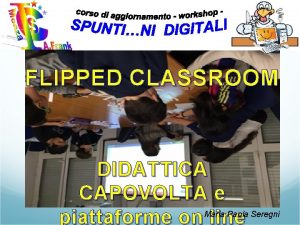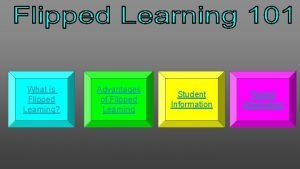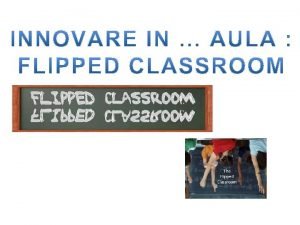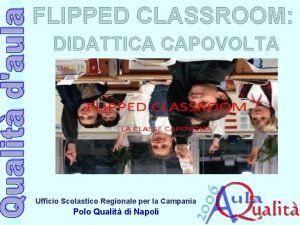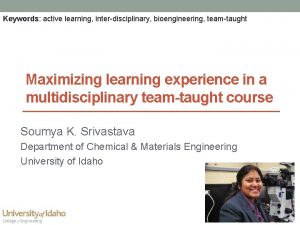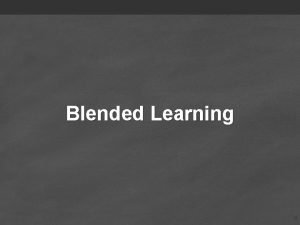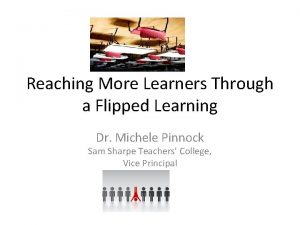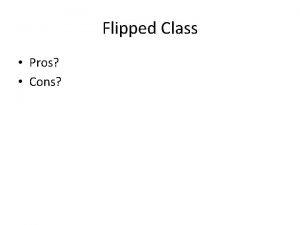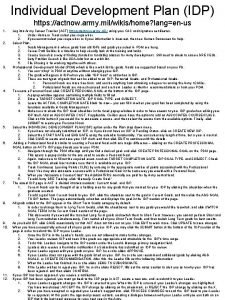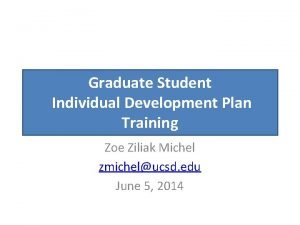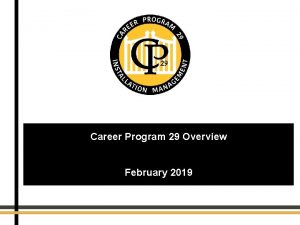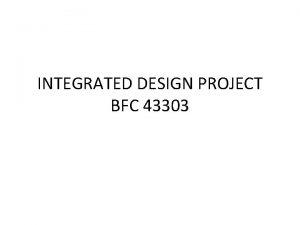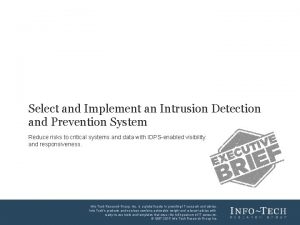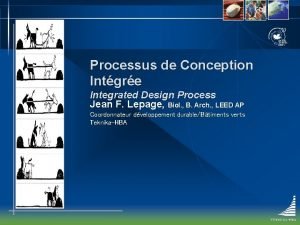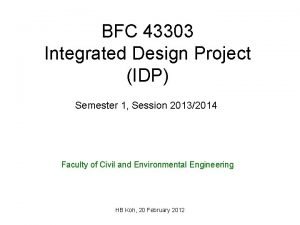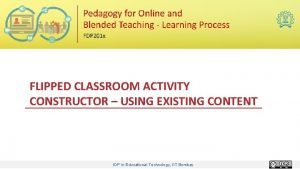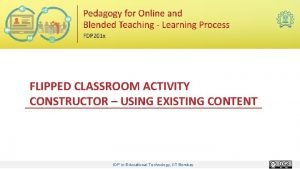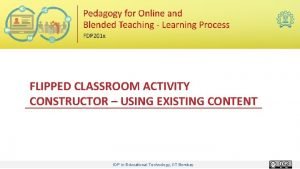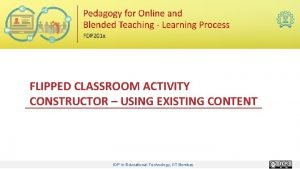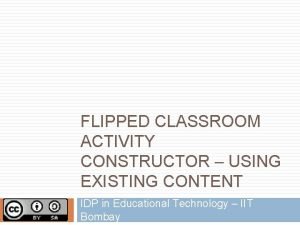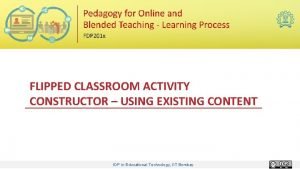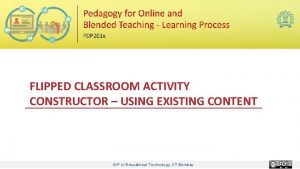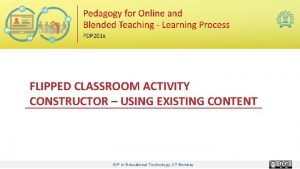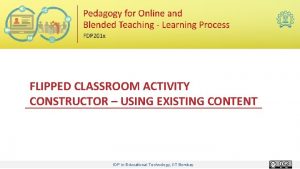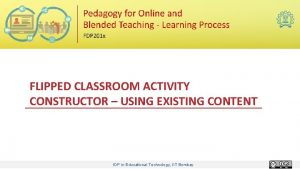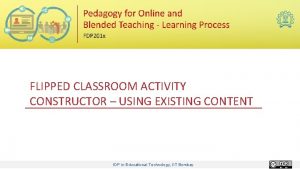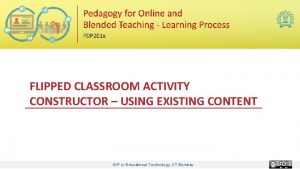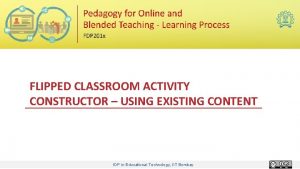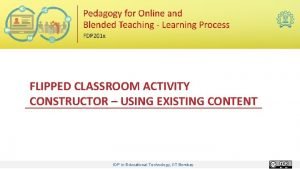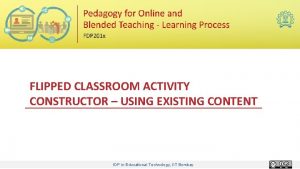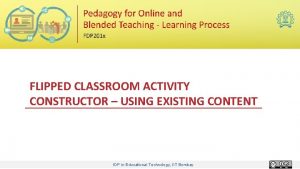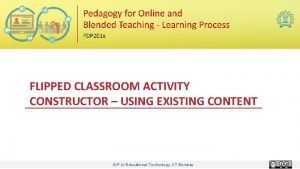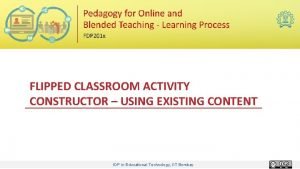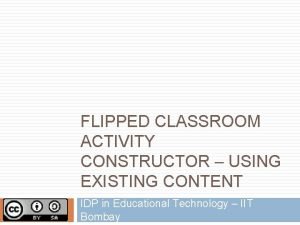FLIPPED CLASSROOM ACTIVITY CONSTRUCTOR USING EXISTING CONTENT IDP




















- Slides: 20

FLIPPED CLASSROOM ACTIVITY CONSTRUCTOR – USING EXISTING CONTENT IDP in Educational Technology, IIT Bombay

About this constructor § § § This activity constructor document is aimed at assisting teachers in designing Flipped Classroom Activity in their own course using existing content. This guide will deal with Open Education Resources (OER’s) or those licensed under Creative Commons. The slides with white background are information sheets. The slides with Pale-yellow background require you to provide inputs. Replace the text written in BLUE with your input. This will be followed by an example input. IDP in Educational Technology, IIT Bombay 2

Table of Contents SECTION SLIDE # ABOUT ME 4 OUT-OF-CLASS SEGMENT 7 IN-CLASS SEGMENT 19 EVALUATION 32 COMMUNITY BUILDING IDP in Educational Technology, IIT Bombay 3

About Me I am Dr. V Srinivasa Reddy, Professor in Department of Civil Engineering, GRIET, Hyderabad ( RC 1080) https: //drvsr. wordpress. com/ https: //rc 1080 griet. wordpress. com/ I intend to design a flipped classroom for the Topic in Structural Analysis • Kani’s Method of Analysis IDP in Educational Technology, IIT Bombay 4

Dr. V Srinivasa Reddy ( RC 1080) KANI’S METHOD OF ANALYSIS STRUCTURAL ANALYSIS CIVIL ENGINEERING B. TECH – III Year- I Sem. Students GOKARAJU RANGARAJU INSTITUTE OF ENGINEERING AND TECHNOLOGY HYDERABAD ( RC 1080) IDP in Educational Technology, IIT Bombay 5

Out-of-class Segment This section helps you design the Out-of-Class segment of Flipped Classroom Strategy. IDP in Educational Technology, IIT Bombay 6

About Out-of-Class Segment § § Meant mainly for Information-Transmission to student. Mostly help achieve lower-order cognitive levels (Recall-Understand-Apply) Teacher takes time to search and locate videos. Out-of-Class activity should not be too lengthy, (ideally think of 1 lecture being transferred outside) IDP in Educational Technology, IIT Bombay 7

Out-of-class Activity Design -1 Learning Objective(s) of Out-of-Class Activity At the end of watching the videos student should be able to: 1. Fixed End Moments 2. Understand Rotation Factors 3. Determine End Moments using Kani’s Method Key Concept(s) to be covered 1. Rotation Factors 2. Rotational Contributions IDP in Educational Technology, IIT Bombay 8

Guidelines for Video Selection - 1 § First check in National Repositories • • § NPTEL Videos (http: //www. nptelvideos. in/) NPTEL Youtube Channel (https: //www. youtube. com/user/nptelhrd) Second Look in International Repositories • • • OER Commons (https: //www. oercommons. org/) OCW Consortium (http: //www. oeconsortium. org/) Open Learing Initiative (http: //oli. cmu. edu/) IDP in Educational Technology, IIT Bombay 9

Guidelines for Video Selection - 1 § Third Look in Internet Video Repositories (filter for Creative Commons License) • • Youtube (https: //www. youtube. com) Vimeo (https: //vimeo. com/) Please note that Repository List is not exclusive and there are many more in the web. Please check this link from Edutopia for more information. IDP in Educational Technology, IIT Bombay 10

Guidelines for Video Selection - 2 § § § Keep the length of video short (not more than 10 minutes). This is because it has been found that shorter videos are more engaging[1]. If the topic is too big for a single 10 min video, split the topic into multiple videos and give instructions to pause. (E. g. Pause at 4: 30 sec) Select videos that have both text and audio narration. This will help in assimilation of content easier[2]. • Guo, P. J. , Kim, J. , & Rubin, R. (2014, March). How video production affects student engagement: An empirical study of mooc videos. In Proceedings of the first ACM conference on Learning@ scale conference (pp. 41 -50). ACM. • Mayer, R. E. (2008). Applying the science of learning: Evidence-based principles for the design of multimedia instruction. American Psychologist, 63(8), 760 -769. IDP in Educational Technology, IIT Bombay 11

Out-of-class Activity Design - 2 https: //www. youtube. com/watch? v=k. QTR 41 -AQEw Main Video Source URL Standard You. Tube License of Video Mapping Concept to Video Source VIDEO SEGMENT DURATION (in min) V 1: 0. 00 - 2. 43 Cycles of Rotational Contribution V 2: 2. 43 - 10. 11 7. 68 Final End Moments V 3: 10. 11 -12. 25 2. 14 CONCEPT Fixed End Moments/ Rotational Factor TOTAL DURATION 12. 25 min Download Notes : -https: //goo. gl/Keqo. R 1 IDP in Educational Technology, IIT Bombay 12

Guideline for Designing Assessments § § § It is recommended to provide few assessment with each video resource. The assessment has to be at lower cognitive levels (Recall – Apply), aligned to the learning objectives. It is recommended that you evaluate these assessments before the in-class to understand the level of students. IDP in Educational Technology, IIT Bombay 13

Out-of-class Activity Design - 3 Aligning Assessment with Learning Objective 1 Assessment Strategy Expected duration (in min) Additional Instructions (if any) Determine Fixed End Moments Determine fixed end moments for beams loaded with central point load, UDL , eccentric load 3 min Watch video snippet 1 Calculate Rotational Factors Calculate Stiffness of various members based on far end support condition 3 min Watch video snippet 1 IDP in Educational Technology, IIT Bombay 14

Out-of-class Activity Design - 3 Aligning Assessment with Learning Objective 2 Assessment Strategy Expected duration (in min) Additional Instructions (if any) Cycles of Rotational Contributions Fill up Kani’s cycles Table for 3 iterations 10 min Watch video 2 snippet IDP in Educational Technology, IIT Bombay 15

Out-of-class Activity Design - 3 Aligning Assessment with Learning Objective Assessment Strategy Expected duration (in min) Additional Instructions (if any) Evaluate Final End Moments Calculate end moments 1 min Watch video 3 snippet Total activity duration = 12 min IDP in Educational Technology, IIT Bombay 16

In-class Segment This section helps you design the in-class segment of Flipped Classroom Strategy. IDP in Educational Technology, IIT Bombay 17

About In-Class Segment § Make sure that In-Class segment contain activities for effective learning • • • § § § In active learning student goes beyond listening, copying of notes. Execution of prescribed procedures. Students are required to talk, write, reflect and express their thinking. Engage students in higher-order thinking (Analyze-Evaluate-Create). Ensure that students get feedback on their work, either from peers or you. Ensure to provide summary that connects Out-of-Class and In-Class activities. IDP in Educational Technology, IIT Bombay 18

In-class Activity Design -1 Learning Objective(s) of In - Class Activity At the end of the class, students will be able to: 1. Find fixed end moments of beam with different types of loadings 2. Perform cycles of rotational contribution of all support conditions 3. Determine final end moments and draw BMD. Key Concept(s) to be covered 1. Expose them to different types of loadings 2. Calculate stiffness of beams with various support conditions 3. Perform cycles of rotational contribution IDP in Educational Technology, IIT Bombay 19

In-class Activity Design -2 Active Learning activity(ies) that you plan to do 1. Think Pair Share Activity Explain the strategy by giving details of 1. Teacher will test the application of conceptual understanding ( real time scenarios) by posing different questions 2. Student will give his opinion and thoughts /ideas to resolve Justify why the above is an active learning strategy 1. Concept clarification using Peer instruction and real time applications using TPS 2. There is also feedback provided (either through peer discussion or instructor summary) IDP in Educational Technology, IIT Bombay 20
 Paola seregni
Paola seregni Flipped classroom advantages and disadvantages
Flipped classroom advantages and disadvantages Venitemi dietro con l'occhio significato
Venitemi dietro con l'occhio significato Moodle meg
Moodle meg Flipped classroom schema
Flipped classroom schema Bioengineering flipped classroom
Bioengineering flipped classroom Flipped classroom
Flipped classroom Flipped classroom examples
Flipped classroom examples Flipped classroom pros and cons
Flipped classroom pros and cons Army actnow
Army actnow Individual development plan examples
Individual development plan examples Army career programs
Army career programs How to collect rsi logs in juniper
How to collect rsi logs in juniper Bosch abc contractor
Bosch abc contractor Glipmpse
Glipmpse Lanfh
Lanfh Idp vsko
Idp vsko Idp vendor landscape
Idp vendor landscape Idp coop
Idp coop Idp project for civil engineering
Idp project for civil engineering Cse smart class
Cse smart class
